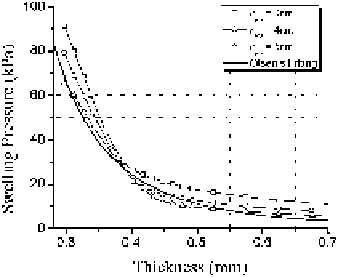Biomedical Engineering Reference
In-Depth Information
Fig. 2.6
Swelling pressure
vs. corneal thickness around
the physiological condition
(
t
=
0
.
5mm)bythe
molecular-level unit cell
model. The average charge
density
ρ
eff
/F
=
48 mM and
the radius of the GAGs rod
varies from 3 to 5 nm, the
ratio
α
=
4
.
0 and charge
fraction
λ
=
0
.
5
Figure
2.6
shows the computed swelling pressure versus the tissue thickness.
The cell effective charge density is taken to be
ρ
eff
/F
=
48 mM. The interfibrillar
spacing
l
c
=
53 nm, radius of the collagen fibril
r
c
=
12
.
5 nm, and the coating radius
r
c
=
18 nm have the same values used in the previous models. The molecular length
ratio is taken to be
α
0
.
5. We have
studied the model under GAGs radii varying from 3 to 5 nm. The sensitivity of the
results with respect to
r
g
is presented in Fig.
2.6
. An increase in the effective GAG
radius leads to a decrease in the computed swelling pressure, as expected, because
the charge density
ρ
g
in the GAG cylinders drops. From Fig.
2.6
, we observe that
r
g
=
=
4
.
0, and the charge partition fraction
λ
=
∼
3
4 nm gives a result that matches the experimental curve well.
2.5 Discussion
In this work we have compared predictions for equilibrium swelling pressure of the
human stroma using three models. Each model provides a representation of the elec-
trostatic forces arising from the charges associated with the linear GAG chains of
the tissue PGs and with the mobile ions in the polyelectrolyte phase. The first to be
considered was a continuum model based on Donnan equilibrium which requires
the electrostatic potential to be spatially invariant. This allows no representation of
molecular-level or microstructural-level information. This model was based on a
uniform fixed charge density that has been reported from independent experimental
measurement. The model equates the Donnan osmotic pressure difference between
the polyelectrolyte phase and bath with the swelling pressure. The prediction for
equilibrium swelling pressure at physiological hydration is reasonable but the ap-
proach severely underestimates swelling pressure at lower hydration levels.
The second model is also a continuum model. It is a unit cell approach and based
on a thermodynamic derivation for the swelling pressure in which the swelling pres-
sure emerges as the derivative of the electrostatic free energy with respect to the
swelling volume. In this model, the electrostatic potential is found from the Poisson-
Boltzmann equation. This model contains no molecular-level information but does
describe the microstructure of the tissue. In particular, it accounts for the polyelec-
trolyte phase being excluded from the volume occupied by collagen fibrils. As the

